Abstract
The built environment accounts for the highest share of energy use and carbon emissions, particularly in emerging economies, caused by population growth and fast urbanization. This phenomenon is further exacerbated under extreme climatic conditions such as those of the United Arab Emirates, the context of this study, where the highest energy share is consumed in buildings, mostly used in the residential sector for cooling purposes. Despite efforts to curb energy consumption through building energy efficiency measures in new construction, substantial existing building stock and construction quality are left out. Construction defects, particularly in the building envelope, are recognized to affect its thermal integrity. This paper aims, first, to detect through thermography field investigation audit construction defects bearing thermal impacts in existing and under-construction residential buildings. Then, through a qualitative analysis, we identify the resulting energy, cost, and health impacts of the identified defects. Results indicate that lack or discontinuity of insulation, thermal bridging through building elements, blockwork defects, and design change discrepancies are the recurrent building and construction defects. The qualitative review analysis indicates substantial energy loss due to lack of insulation, thermal bridging with cost and health implications, while beneficial mitigation measures include consideration of building envelope retrofitting, skilled workmanship, and the call for quality management procedures during construction.
1. Introduction
The quest for energy efficiency in the built environment has driven substantial research and technology advances to curb the ever-increasing energy demand needed to service human needs. Developing countries and emerging market economies, in particular through population and economic growth, drive the demand for fossil fuel [1], which certainly brings more prosperity but, at the same time, aggravates the resulting impacts of climate change [2]. The building industry accounts for the largest percentage of the total energy use and carbon emissions globally [3], a fact often further exacerbated by extreme climatic conditions and late or inadequate implementation of building energy efficiency measures. Nevertheless, the worldwide agenda of an energy-efficient built environment has been embraced globally, yet with different contextual challenges and variable accomplishments.
The United Arab Emirates (UAE), the context of this study and similar to many fast growing economies, has witnessed high population and economic growth and an extremely fast urbanization in the last four decades, a result of its immense oil revenues. The UAE population stands at 9.8 million in 2020 from a mere 1 million in 1980 [4]. The total population of Dubai, for example, has grown by 1000% over the last 40 years alone [5]. Most of the population (over 85%) lives in urban settings [6]. The result has been an unprecedented urban growth with, however, minimal consideration for non-renewable resources and energy-related repercussions until 2010 [7]. The construction sector in the UAE stands as a leading economic sector that has garnered global interest regarding the quality and energy impacts of the resulting booming construction. In terms of energy usage, the built environment in the UAE accounts for 70% of energy consumption, mainly used in cooling, compared to the global average of 40% [8]. For instance, Abu Dhabi, the largest emirate, contributes up to 22% of active projects and 38% of the total value of projects [9]. The Abu Dhabi region occupies the first position in terms of the number of constructed buildings in the UAE, where around 80% of electricity consumption is attributed to buildings alone [10], a fact that has positioned the UAE as one of the world’s largest energy consumers per capita, with a demand trend expected to intensify [11].
Amid the country’s overall growth, the main component of the urban fabric in the UAE is the residential sector, which leads the way in energy usage and carbon emissions. The residential market sector is mainly in the form of extensive government-sponsored housing programs and large privately developed rental developments [10]. Within the residential sector a significant amount includes existing and newly constructed detached or semi-detached houses, amounting to about 65% of the urban fabric, according to the National Statistics Center [10], widely recognized as the most demanding type of buildings in terms of cooling, especially under the local extreme hot climate [12]. The UAE’s desert climate, characterized by extreme high summer temperatures, with a maximum annual temperature average of 45 °C in August, high solar radiation, and high humidity on the coastal zones, imposes serious challenges to both designers and owners alike. The design and construction challenges reside in adapting the intended building to the extreme hot climate of the UAE, while building owners have the challenging task to alleviate the high running energy cost. This climatic condition, along with building design, construction type, quality and materials, plays a critical role in the overall building energy performance. Unlike the climatically adapted vernacular houses, contemporary internationally styled houses in the UAE have disregarded the climatic construction methods and cultural context and relied on active cooling and ventilation systems for thermal comfort. The construction methods and materials used in housing were not controlled until rather recently, despite the harshness of climate and its impact on a building’s cooling needs and increasing electrical demands [13].
The central government acknowledged the importance of targeting building energy use as key to reducing both the country’s energy consumption and carbon emission and introduced several energy conservation measures and control procedures that apply to new construction. In fact, it was not until 2010 that the Urban Planning Council in the Emirate of Abu Dhabi established Estidama, the local sustainability framework [14], which aims at achieving sustainability and energy conservation in buildings through the provision of guidelines for newly constructed buildings. Similarly, the Green Regulations and Specifications in the Emirate of Dubai (2011) was established as a first step toward implementing green building strategies. It came into effect in 2011 as mandatory for governmental buildings while remaining voluntary for private ones. The focus in both resides in the specification of minimum U-values for walls and roofs. For example, in Dubai, Green Building Regulations limit U-values for the roof and walls to a maximum of 0.3 W/m2 K and 0.57 W/m2 K, respectively; whereas in Abu Dhabi, the Estidama PEARL code prescribes (at its lowest rating) maxima for roof and wall U-values of 0.14 W/m2 K and 0.32 W/m2 K, respectively [15]. Alongside an active regulatory implementation of the required measures in new constructions, there has been a wide government call to address the existing building stock in a collective target to reduce energy demand by 30% by 2030. Recently, in 2017, the Ministry of Energy introduced the political feasibility of policy options for the country’s Energy Transition. It announced a new UAE Energy Strategy 2050 that outlines a number of energy targets for 2050, including: energy efficiency targeting a 40% improvement relative to the current annual growth in electricity. Additionally, it targets increased implementation of energy efficiency (EE) standards with monitored building performance and audits to achieve greater EE technology adoption and demand site management [16].
The momentum to address building energy efficiency in UAE targeted first and foremost new constructions with a primary focus on wall and roof insulation, leaving out the status and performance of the relatively new but extensive existing building stock and construction quality and processes. Further, rapid growth puts building and construction quality under pressure but contextual research has so far focused on issues affecting delays and cost [17,18,19]. Under the UAE climate, the building envelope highly contributes to the total heat gain in a building [20]. This factor is important as the building envelope can contribute 50% or more of the embodied energy distribution in major building elements in residential buildings and between 50 to 60% of the total heat gain [21].
Construction defects in housing, specifically the ones occurring in the building envelope, are recognized to contribute to the energy performance gap of the building [22,23] The generally accepted definition of construction defects refers to a deficiency in the construction process, from either design, materials and systems, or workmanship, that leads to some form of failure (financial, safety, performance, or other). The construction defects are extensively addressed in the literature from identification of type, classification and standardization [24,25]; source of the defect (design, workmanship) and origin of defect (change, error, omission, damage) [26,27]; type of defects including missing, misaligned or incorrect installation in different building elements [24,25,28] or, of more relevance, the relationship between quality defects and thermal performance of buildings [22].
However, in the UAE context, research within housing defects, especially those occurring in the building fabric, are extremely limited. The nature, type, and origin of defects have not been explored, either in existing buildings to identify and prioritize mitigation strategies or in the new construction to ensure code and standards deliver as per target. Hence, the aim of this paper is to first identify construction defects that may affect the thermal integrity of the building’s envelope in both existing and under-construction residential buildings via thermal imagery diagnosis. Second, through a qualitative analysis we explore the energy, economic, and health impacts of the identified defects. The intent is to open up ways of addressing them either in terms of optimal retrofitting measures for existing buildings or construction quality processes during construction. Identifying defects in existing buildings caused by building age, deterioration, and workmanship defects may guide or prioritize actions and type of retrofitting measures, yielding optimum benefits. Defects identified and categorized in housing during construction can assist in establishing adequate and early mitigation strategies during the construction process.
2. Materials and Methods
This study comprises a field investigation and a qualitative review analysis. First, the field investigation through Infra-Red Thermography (IRT) auditing in both existing residential buildings and under-construction housing units is presented. Thus, thermal imaging rationale, validity, and procedure are presented first. Then the various impacts of the identified construction defects are assessed through a qualitative review analysis.
2.1. Thermal Imaging and Building Envelope
Infra-Red Thermal (IRT) imaging is a non-destructive technique utilized to perform qualitative and quantitative tests on the building envelope to identify various defects that contribute to energy loss [29]. IRT is used to obtain empirical data for building envelope performance in heat loss/gain, air leakage, and moisture problems through thermal images that indicate external and internal surface temperature differences. Kylili et al. [30] recognized IRT as one of the most appropriate nondestructive imaging techniques, a widely used tool to quickly identify potential building defects among researchers and practitioners [30]. Since IRT is used to obtain empirical data for the actual thermal bridging, it has become particularly useful at the post-construction stage in assessing energy efficiency where the designed U-values are compared to the measured values [31]. Further, in already built structures walkthrough internal thermography assessments were found to substantially detect more defects than other IRT approaches [32]. It can also be a useful tool for retrofitting, thus enabling grant-providing authorities to assess gains in thermal performance of the retrofitted building envelope. [33]. As such, Hopper et al. [34] investigated the possibilities and limitations of using IRT as qualitative test method for assessing the installation of retrofitted external wall insulation to pre-1919 dwellings with solid exterior walls [34].
IRT has also been used in under-construction buildings to detect defects. The application of thermography at various phases of the construction process has mainly emerged from field tests on housing projects in Wales, UK [35]. The scope for four types of “in- construction” tests was identified in: (a) making early stage checks on the installation of insulation, (b) identifying air leakage through the building envelope, (c) assessing insulation continuity and the severity of thermal bridges, and (d) investigating the performance of building services [35]. Similarly, Littlewood [36] developed the in-construction testing protocol using thermography to inspect the dwelling envelope under construction, aiming to identify when defects occur that detrimentally affect operational energy use for heating.
2.2. Case Studies
All case studies considered in this study were single-family, detached, or semi-detached residential buildings in the city of Al Ain located in the Emirate of Abu Dhabi. Al Ain city is located inland and is characterized by an extremely hot and arid climate. The case studies included existing buildings and construction sites at different stages of the construction process. Two main types of residential buildings in Al Ain dominate the landscape. The first one is in the form of detached private villas, mostly for nationals, whereas the private rental market is dominated by housing developments of relatively similar layouts. This research investigated both housing typologies for construction defects spread across different sites within the city (Figure 1).
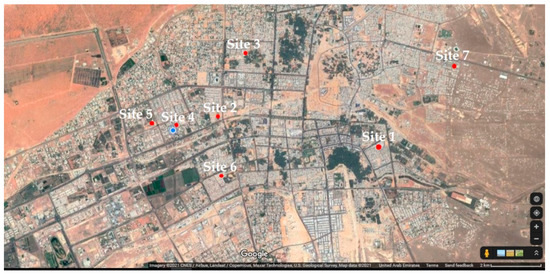
Figure 1.
Site locations of the investigated residential units in Al Ain city (UAE).
The dominant construction method in the housing sector, present in six of the seven test sites, is concrete blockwork infill with a reinforced concrete post and beam structural system. This is also the dominant construction method across the Mediterranean and Gulf region. Site 7 is an exception, as it uses precast concrete structure, which is a rare occurrence in the UAE housing sector. The existing building sites (Site 1 and Site 2) were built over 10 years apart (Figure 2) and were selected to identify the impact of time, workmanship, and construction quality on the building envelope thermal efficiency. These housing units were built before the implementation of the Estidama Building Regulation Code [14], therefore, the exterior walls and roofs were likely to lack any kind of thermal insulation, a shortcoming which is duly expected to highly affect the house energy consumption. In the considered two sites, the U-value of the exterior walls and roof were 2.319 and 2.849 W/m2 K, respectively, per submitted values of building permit. On the other hand, the exterior envelope of the residential units under construction (Figure 3) adhered to building Estidama energy code [15], where the U-value of the exterior walls and roof were 0.29 and 0.14 W/m2 K, respectively. Separate thermal thermography investigations conducted in these buildings are summarized in Table 1.
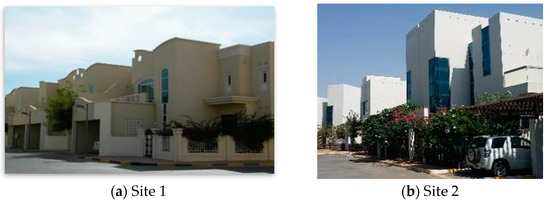
Figure 2.
Existing residential buildings in (a) Site 1 completed in 1999, (b) Site 2 completed in 2010.
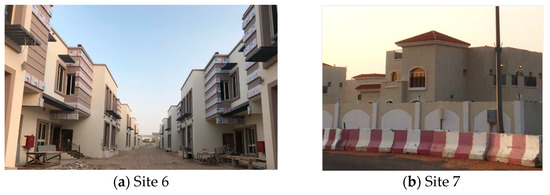
Figure 3.
Under-construction residential units in (a) Site 6 and (b) Site 7.

Table 1.
Construction status and residential units’ characteristics in each investigated site.
2.3. Testing Procedure
The Infra-Red Thermography (IRT) investigation requires adherence to specific environmental conditions. The temperature gradient between the interior and the exterior of the investigated building should be at least 10 °C [37]. In this study, the passive approach was used as an analysis scheme for the investigation of thermal patterns on the building envelope to detect temperature differences under natural conditions [30]. Similarly, in Bauer et al.’s study [38], a thermographic survey using the passive approach was used to detect defects on ceramic tiles and cracks in the mortar. The most significant outcome of the study was that the identification of the surface temperature abnormalities depended on various conditions such as orientation of the building or direction of solar radiation. The results specified the correct inspection time after the defect type on the surface and correct direction of heat flow were defined.
The thermal investigation included an internal and external survey of selected elevations of the buildings with close-up thermograms for specific analysis, using a thermal imaging camera following the infrared methodology of the qualitative detection of thermal irregularities in the building envelope standard BS EN 13187:1999 [39]. For the existing building thermal survey, the passive analysis scheme was used; the target is typically an exposed structural element and measurement was performed from the interior of the building. Residents were asked to keep the air conditioning on for four hours prior to the test time to keep the indoor temperature constant. In the thermal investigation of buildings under construction, the external energy source is the Sun, where buildings are illuminated by periodically changing solar radiation and exposed in an atmospheric temperature. The north elevation was selected for investigation for each building to avoid direct solar radiation. The physics of periodic heating/cooling by solar radiation was used by Mathur et al. [40] to illuminate a concrete slab by a periodic changing of solar radiation and bathing in an atmospheric temperature [40]. For analyzing and measuring thermal images in this research, the qualitative analysis was based on the evaluation of differences in measured radiation by inspection of color patterns within a thermal image [41].
3. Results of Field Investigation: Building Defects Detection through Thermal Imaging
The thermal imaging audit revealed several recurrent issues in the form of thermal bridging within the exterior envelope in most of the investigated buildings, as shown in Table 2. Among the issues encountered, the dominant one found in most buildings was the non-insulated structural frames, followed by blockworks defects, then non-compliant design changes. These issues relate to workmanship errors, as well as to design and construction non-compliant decisions. The thermal investigation of Site 7 showed no significant areas of concern regarding thermal bridging, given the precast construction model and the minimal opportunities for workmanship errors or design changes. This is in line with the acknowledgment that prefabrication has been generally considered a more sustainable method in the building sector, supported by evidence of the demonstrated energy-saving potential of prefabrication based on life cycle analysis and thermal performance evaluation [42].

Table 2.
Classification of identified construction defects in the investigated sites.
3.1. Construction Quality in Existing Buildings
The audit of selected units from the existing housing in Site 1 and Site 2, which were built 10 years apart, highlighted a number of common thermal behaviors and some variations. First, as expected, it identified the absence of insulation in the exposed building envelope, such as in the roof and exterior walls in both sample units (Figure 4 and Figure 5), which critically calls for retrofitting as remediation. In the thermogram of the sliding door opening in the Site 1 unit, the line analysis on the concrete block wall around the opening showed the average temperature of the concrete block wall was 29 °C, while the line analysis on the concrete block wall around the sliding door opening in the Site 2 unit was 32.1 °C. The Site 2 unit showed more thermal anomalies between the sliding door frame and the exterior wall, compared to the Site 1 unit. This was likely caused by a construction defect related to poor sealing (Figure 6).
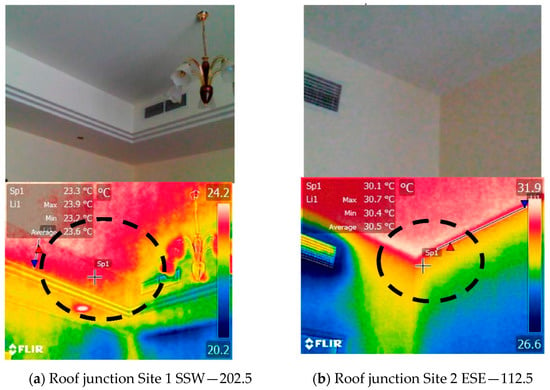
Figure 4.
Thermogram of roof junction showing lack of roof insulation in existing buildings of Site 1 and Site 2.
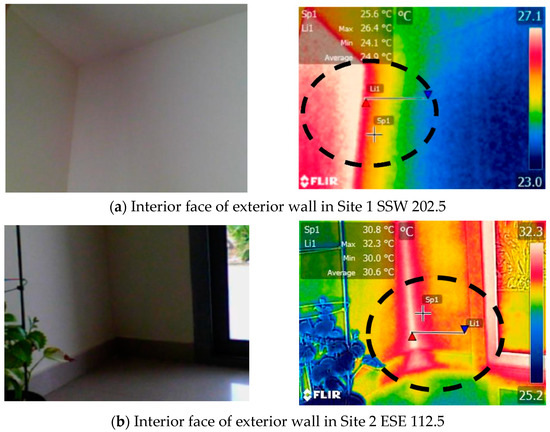
Figure 5.
Thermogram showing higher surface temperature of the non-insulated exterior wall in existing buildings of Site 1 and Site 2.
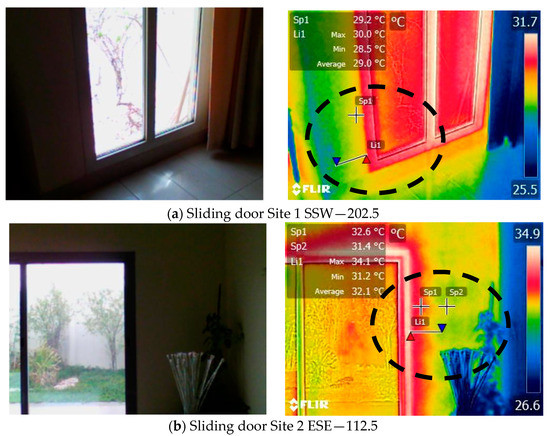
Figure 6.
Thermogram of sliding door in Site 1 and Site 2.
These results highlighted the strong relationship between workmanship, construction quality, and the thermal behavior of the building’s envelope. Unexpectedly, the results showed more thermal anomalies in the newer units of Site 2 completed in 2010 than the older ones (Site 1, built in 1999), thus indicating that the thermal behavior of the two buildings was more a function of workmanship and construction quality than simply building age. This further reinforces the need to diagnose defects during construction, which, although costly, are preventable if detected and remediated early enough.
3.2. Uninsulated Structural Elements
The thermal imaging investigation in under-construction sites indicated primarily the thermal bridging between the building components where structure composition changes. The exterior walls of the case study consisted of Autoclaved Aerated Concrete (AAC) blocks with a U-value of 0.29 W/m2 K that met the required energy efficiency code, and a non-insulated reinforced concrete frame (2.398 W/m2 K). In Figure 7, the thermogram showed the interior face of an exterior wall in Site 4 where both the concrete blocks and reinforced concrete frame indicated different thermal behaviors against absorbed solar energy, which led to a form of thermal bridging. Another example of an exterior wall can be seen in Figure 8, with a thermal variation between the concrete blocks and reinforced concrete frame in the range of 2 °C. The cavity-insulated concrete blocks limited the amount of stored solar energy, while the high thermal mass of the reinforced concrete frame structure stored and transferred more heat. The impact of such defects was explored by Friess et al. [13], who evaluated through simulation the role of thermal bridges between concrete blocks and the reinforced concrete frame of residential villas in Dubai. The results suggest the importance of adding insulation to the entire opaque envelope.
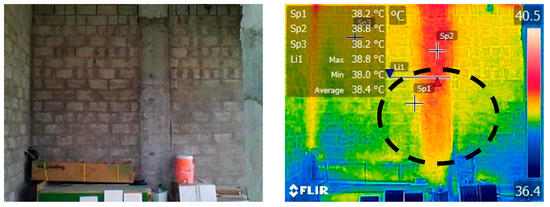
Figure 7.
Thermogram of interior face of exterior wall in Site 4 (North façade).
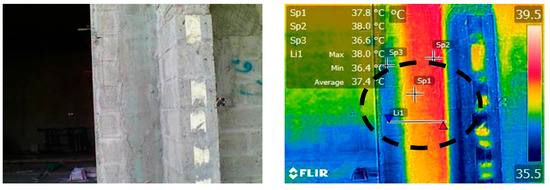
Figure 8.
Thermal pattern of the exterior wall in Site 4 (North façade).
3.3. Blockwork Defects
In the under-construction sites, the Autoclaved Aerated Concrete (AAC) construction blocks can offer significant energy savings, thermal bridging control, and air-tightness of buildings due to their thermal mass and integrated insulation [43]. However, the thermal integrity of a wall can be compromised by poor workmanship, which would lead to thermal bridging. The thermal investigation exhibited different types of anomalies in the otherwise insulated blockwork. These were observed in three sites (Sites 3, 4, and 5) and the thermal defects were due to oversized service outlets and mortar joints. Figure 9 shows the thermograph of an exterior wall made of AAC blocks with provision of electricity outlets. The temperature of the spot check of the electricity outlet area was 38.2 °C, while the temperature of spot check of AAC block was 37.6 °C, with a temperature difference of 0.6 °C. In Figure 10, the thermogram shows a temperature variation of the interior face of the AAC exterior wall due to different mortar joint sizes. Both cases acted as thermal bridges that increased transmission loads and reduced wall thermal resistance (R-value). Al-Sanea and Zedan [44] reported experimental results of the mortar joints effect on R-value, indicating that for a typical wall with insulation thickness of 75 mm, mortar joints with Hmj = 10 mm (corresponding to 4.8% thermal bridge area) increase peak, daily, and yearly cooling and heating transmission loads by 62%, while the wall R-value decreases by 38%, compared to a similar wall with no mortar joints (Hmj = 0) [44].
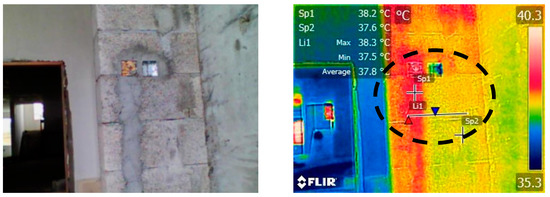
Figure 9.
Thermogram showing oversized provisions for electrical services (exterior wall; Site 3).
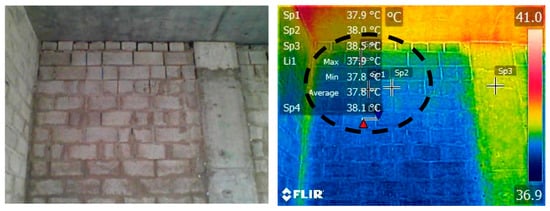
Figure 10.
Thermogram showing oversized mortar joints in the blockwork (interior face of exterior wall; Site 5).
3.4. Design Discrepencies
Another defect identified during the testing of under-construction units was the result of design change with non-compliant construction details. This was not as frequent but still a recurring defect. In this investigation, the design change was caused by a client’s choice, where exterior windows became fake windows kept for aesthetic reasons, but with non-insulated concrete fill (Figure 11). Thermographs showed discrepancies of the thermal behavior of the wall as a result of the non-insulted concrete fill and heat gain through convection of hot trapped air. The average temperature on the concrete block wall was found to be 34.6 °C in Site 6, and the difference between the concrete wall and the fake window area was 5.5 °C. In the thermograph of Site 3, there was a temperature variation in the range of 4.8 °C within the same wall due to the fake window and the non-insulated fill (Figure 12). Design changes in the construction phase with implementation defects may well be a main unaccounted-for source of heat gain in otherwise insulated buildings. Although they are more common than exceptional, their consequences have been largely ignored in simulations despite their possible significant reduction of the global thermal resistance of the envelope.
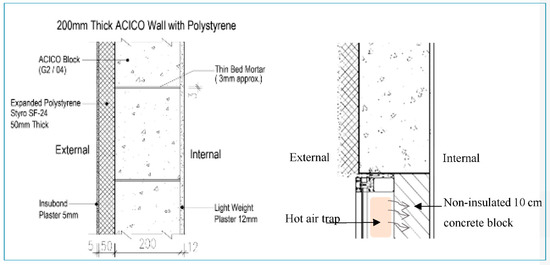
Figure 11.
Construction details, (left) Typical wall construction (Site 6); (right) Heat gain through convection as a result of non-compliant design changes.
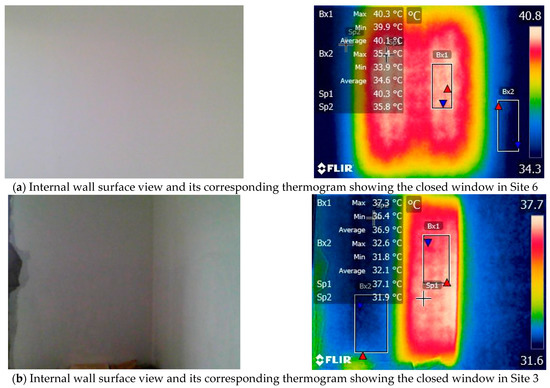
Figure 12.
Thermograph of interior face of fake exterior window with non-insulated material fill (Site 6).
Finally, the building and construction defects identified in this field investigation may be best categorized as per their type, location, origin, possible source of error, and thermal impacts, as indicated in Table 3. Most of these defects are linked to workmanship, likely a lack of skilled workers, and insufficient site controls. The current construction quality control procedure does not include verification of construction thermal defects, relying solely on specifications and building energy performance simulations, whereas field studies and post-construction status highlighted major energy impacts, largely due to construction defects. The impacts of these defects are explored next through a qualitative review analysis.

Table 3.
Summary synthesis of identified building defects.
4. Qualitative Impacts Analysis of Identified Building and Construction Defects
The construction defects identified in the field investigation conducted in the UAE are not unique, but recurrent in many other countries. A large body of literature shows that the same construction defects, led by limited energy standards, thermal leaks and bridging, and design discrepancies, induce multiple impacts. Hence, the qualitative review analysis carried out next aimed to unveil the relationships between the defects and their impacts, leading to higher energy consumptions, poor building systems performance, occupants’ discomfort, and additional issues. Table 4 summarizes the literature findings grouped under the three major construction defects identified through the thermal imaging field investigation and their respective impacts, which are discussed in detail next.

Table 4.
Summary of the literature on impacts of building and construction defects.
4.1. Non-Insulated Building Envelope
The audited existing housing built prior to the implementation of the energy building code in UAE all had non-insulated walls and roof. Lack of insulation is a well-reported issue in the literature as dramatically reducing the thermal performance of buildings [22,45,87,93,94,95]. In the UAE as well as in numerous other contexts, this is mainly due to the lack or late implementation of regulations that enforce the installation of thermal insulation [46]. The lack of insulation clearly results in high heat loss or gain, leading to high energy consumption [13,20,45,50], high running cost [52,53,54], increase in CO2 emissions [20,53] as well as negatively affecting building users’ comfort [96]. The impact on energy was found to be substantial, ranging from almost 25% [13] to 78% [48]. Even in a less extreme climate, such as the Mediterranean region, the lack of insulation significantly contributed in raising the energy consumption where the opaque external elements of the building without insulation contributed approximately 50% of the total cooling load [52]. Several studies proved that the impact of the missing insulation in the building walls and roof is not limited to high energy usage, but consequently increases the annual energy cost [52,54] as well as limits thermal comfort to very short periods [96].
The absence of building insulation is a scenario that calls for multiform actions: at the forefront, the establishment of rigorous standards and codes that will govern new construction, a practice that has been embraced in the UAE through Estidama in the Emirate of Abu Dhabi, with other emirates following the same path [97]. On the other hand, addressing the low performance of the existing building stock calls for retrofitting measures [48,49,50,51]. Researchers have stressed the importance of establishing high energy standards and strict regulations for upgrading the existing design to acceptable thermal insulation requirements. The benefits of using thermal insulation in buildings have been extensively addressed [20,49]. A study in the UAE estimated, through energy modeling of an existing villa, a 37.2% reduction in the total annual cooling load when thermal insulation refurbishment is upgraded to the Estidama 1 Pearl requirements [46]. Similarly, in another context, Altun et al. [54] estimated that adding insulation to meet current standards improves the building’s annual heating energy up to 75%, 70% for life-cycle cost, and 73% for life-cycle greenhouse gas emissions, with a payback period under two years for the greenhouse gas and under seven years for the initial investment cost [54].
A number of retrofitting measures to mitigate the negative impacts of the lack of insulation on the energy consumption, cost, and users’ comfort have been commonly addressed. In their extensive research, Brannigan and Booth [53] addressed the selection criteria for the most suitable mitigation strategy, taking into consideration cost savings, minimal disruption during installation process, and resulting aesthetics of the property. The findings indicate that the challenge resides in the type and the thickness of the insulating layer [96]. Material types and the thickness of the thermal insulation of exterior walls exhibited a material-based variable optimal economic thickness [98]. Different thermal insulation materials have been tested to examine the most effective ones, with a high agreement on the efficiency of extruded polystyrene in reducing heat loss and saving energy [13,48,52]. However, the increased insulation may lead to higher levels of indoor pollutants and condensation issues calling for ventilation upgrades [51].
Heat loss or gain is not limited to the missing thermal insulation in the building envelope, but as revealed in the thermography diagnosis and supported by the reviewed literature, thermal bridging in the structural elements as well as at slab–wall junctions, window–wall junctions and balcony joints is a leading cause of the thermal energy performance gap.
4.2. Thermal Bridging
A thermal bridge is a part of the building envelope where, relative to the surrounding area, the thermal transmittance is considerably greater at the local level [75]. Thermal bridges are primarily caused by geometric or structural effects or by the discontinuation of thermal insulation in whole or in part. Thermal bridges are a major cause of poor energy performance, increasing heating and cooling loads, poor durability, surface damages, poor indoor air quality, and hygiene problems such as mold growth, surface condensation, and the staining of surfaces, resulting in different impacts.
4.2.1. Impacts on Energy
The various construction defects identified in the field study lead primarily to thermal bridging, a result of heat loss or gain that impacts energy usage. Numerical and experimental studies have assessed the negative thermal impacts of different types of thermal bridges. The qualitative review presented next analyzed thermal bridges according to the type of defect and uncovered a pattern of negative impacts within building connections, windows, walls, and other miscellaneous openings.
The overall effect of thermal bridges in building junctions increased the thermal losses through the building envelope by about 9% in an experimental building setup in which infrared thermography assessment was used [29]. In a similar UAE climatic context, a numerical study for a typical villa in Kuwait showed that due to uninsulated columns and beams the thermal resistance of buildings can be reduced by 48% [66]. In a milder Mediterranean climate, a similar conclusion was reached, where the correction of thermal bridges studied on pillars, balconies, and slab–wall junctions resulted in an overall annual energy saving of 8.5%. The savings were also reflected in the primary energy needs for heating, where 25% and 17.5% reductions were achieved for terraced houses and semi-detached houses, respectively [71]. Similarly, the analysis of a building’s thermal behavior showed that the design and construction choice of balconies and foundations had the biggest impact on the value of linear thermal bridges. It was shown that correct design solutions can improve the value of linear thermal bridges up to 13 times [67]. Moreover, a study done on Greek single-family houses showed that the impact of thermal bridging on the overall annual heating load was estimated at 13%. The investigated retrofit solutions applied to balconies and window edges achieved a decrease of the annual heating energy requirement from 4 to 10% [69].
A similar pattern of results was reached under extreme climate conditions, cold in this instance, where the results of the simulation of a high-rise residential building in British Columbia displayed an increase in the annual heating energy load by 37.4–42.2% from different thermal bridge connections, such as: intermediate floor junctions, intermediate wall/window junction, balcony junctions, balcony sliding door junction, partition wall junction, roof junction, and basement wall junction [99]. The previous results also aligned with the results found by Jedidi and Benjeddou [65] in which thermal bridges caused additional heat losses exceeding 40% of the total heat losses through the envelope. Increasing the insulation on the corners showed a positive effect on thermal bridging [65].
In studies exploring the impact of added insulation on building thermal performance, the thickness, material type, and insulation location exhibited different results. An increase of 50% and 100% in the thickness of the insulation considerably decreased the U-value, linear heat loss coefficient ψ, and surface temperature factor fRsi [65]. Karabulut et al.’s [70] study indicated that the heat transfer rate did not decrease in the heat bridge region with internal insulation, while the most suitable insulation model was the outer insulation. The previous studies were supported by Erdem and Pinar [56], who studied the impact of internal aerogel retrofitting on the thermal bridges of residential buildings; their findings confirmed that the simple internal retrofit by insulation is not the optimal solution to reduce the heat losses from residential buildings if appropriate attention is not paid to non-insulated building elements [56]. In this regard, another dominant type of thermal bridging caused by construction defects lies with windows and openings. Marincioni et al. [64] found that the junctions, particularly window jambs and lintels, show the highest transmission heat transfer coefficient. Uninsulated corners and side reveals account for 40–52% of the transmission heat transfer coefficient at junctions for thin walls, while they account for 53–69% for thick walls. When the reveals are insulated, the transmission heat transfer coefficient is lowered by more than two-thirds [64]. Similarly, Ibrahim et al. [47] highlighted that the percentage of the windows’ thermal bridge energy load of the total house load is approximately 4–8% in the case of exterior walls having no interior insulation, and nearly 2–5% in the case of exterior walls having a 5-cm thick interior insulation. Furthermore, when using more exterior insulation, the relative effect of the thermal bridge was higher. As a mitigation strategy, applying a layer of 1 and 2 cm of coating on these thermal bridges lowered the energy consumption by about 36% and 50%, respectively, for the exterior walls with no internal insulation, and by about 24% and 33% in the situation of exterior walls having interior insulation [47]. An increase of the air-tightness level in external windows can also contribute to the reduction of the annual heating energy consumption per unit area of the building. Based on simulations and tests done by Liu et al. [62], the heating energy consumption was reduced by approximately 49%. On another note, the incorrect positioning of the window frame toward the external side or the internal side of the wall was found to increase the linear thermal transmittances by 70–75%. Depending on the jamb’s configuration, the shift from the internal position to the intermediate position can lower the linear thermal transmittance by 31–50%, considering the wall with external insulation. Thermal losses can be further reduced by 52–75% by the shift from the internal to the external position [63].
Walls as diagnosed in the field investigation of this study can be a receptacle of construction defects that can negatively impact the energy loads within a building. Besides poor workmanship, these thermal bridges can occur through walls and affect the thermal gains or losses depending on the construction type of the wall. A study done in the UK measured the thermal properties of 25 new dwellings and concluded that, in terms of construction type, the worst performing construction form is partial fill masonry, which can be particularly susceptible to thermal bypassing and wind washing if it is not assembled correctly or if the levels of workmanship are poor [58]. Supporting the previous study, an analysis conducted by Zedan et al. [55] showed that mortar joints in masonry construction increased the cooling and heating loads almost linearly with the thermal bridge-to-wall-area ratio in a typical two-story villa in Riyadh. The same study concluded that the effects of thermal bridges resulting from mortar joints in walls can be eliminated by using tongue and groove insulated building blocks [55]. In a similar study about commonly used masonry veneer constructions, Finch et al. [100] revealed that masonry ties occupy 0.04% of the overall wall area, and the rules within some energy codes would permit such thermal bridge consequences to be ignored. The findings described in the paper demonstrated that this code compliance generalization results in exaggerated R-values reaching up to 30%. Nevertheless, the correct selection of tie material and tie design, such as carbon fiber or basalt, can reduce the effect of thermal bridging to less than 10% [100].
Comparing the results of traditional wall construction methods with those of the advanced ones, a study on the effect of thermal bridging in ventilated facades presented that thermal bridges in metal cladding systems can lower the effectiveness of the thermal insulation if no specific attention is given during the design and the construction process [57]. The use of a chemical anchor in the ventilated façade can decrease thermal bridge heat flows up to 10% in comparison to steel anchors. In a comparable type of construction, Theodosiou et al. [60] studied the magnitude of problems with the thermal bridge in double skin facades (DSFs). The overall influence on DSFs exceeds 25% of the total heat flow of the envelope, causing a substantial underestimation of the actual heat flow through the envelope of the building [60]. An alternative study on the effectiveness of precast sandwich panel wall construction in four different climatic boundary conditions showed that air circulation around the diagonal tie connectors between the panels can lead to an increase of room heating energy demand by about 7.0–10.3% in all studied climatic regions. Therefore, in precast sandwich panels installation of additional insulation around diagonal tie connectors (DTCs) is required to prevent natural air convection occurring in cavities between two insulation sections [61].
Looking at the structural material used in buildings, Real et al. [59] studied the effect of normal weight concrete (NWC) on thermal bridging and the contribution of lightweight aggregates (LWAs) in concrete to the reduction of the thermal bridging effect in buildings. The results indicated that, depending on the type of LWA, the contribution of thermal bridging in an apartment in Lisbon, Portugal, was 11–19% lower in the case with structural lightweight aggregate concrete elements than in the case with NWC elements. This finding emphasized the importance of selecting a high performing aggregate type in the concrete used in structures to reduce overall thermal bridging in walls [59].
4.2.2. Impacts on Health and User Comfort
The impact of thermal bridges is not limited to energy and resulting operational costs; thermal bridges can have an impact on the health and user comfort. Thermal bridging resulting in lower thermal performance and surface condensation lead to hygiene problems such as mold growth and the staining of surfaces, which affects the user’s comfort levels [75].
Lower thermal performance caused by thermal bridging had a negative impact on building users, as exemplified through a survey conducted in Turkey exploring users’ opinions about air quality conditions in terms of how they feel in winter and summer. Of all the users, 37% complained about the low heating level in winter, while 41% complained about overheating in summer. An investigation of the thermal performance of skeleton structural frame, wall openings, roof, and ground floor was ensued. It was shown that the thermal effectiveness of the wall was diminished by the thermal bridging in reinforced concrete structural elements, contributing to the highest heat loss through the wall [72].
Another potential consequence of thermal bridging impacting human comfort is condensation, which can arise if the internal insulation is improperly installed [73]. Some air-conditioned buildings in warm climates are susceptible to condensation risk [101]. The UAE has both arid and hot, humid climatic zones in which the peak average temperature and humidity can reach 45 °C and 85%, respectively [77]. Infiltration of warm, moist outside air through cracks and holes in the enclosure causes condensation and moisture to develop on materials that are cooler or have been cooled by air-conditioning systems [102]. Moisture issues are sources for indoor air pollutants in the UAE, which highly affects the integrity of indoor air quality (IAQ) of a building and severely impacts human health. This is a critical concern in the UAE where individuals spend most of their time at home due to extreme temperatures throughout the seasons [103]. In hot and humid climates, the overall thermal transmittance performance analysis uncovered envelope failure on surface condensation standards at the present operative conditions, which has also led to mold growth [75]. Similar studies in different climatic conditions have also investigated the effect of thermal bridging on the rise of condensation and have agreed upon the criticality of thermal bridges in terms of surface condensation and mold growth [56,74,75]. An alternative mitigation strategy to counteract the effect of mold formation in walls due to thermal bridging is increased thermal insulation, which raises the indoor temperatures and lowers average relative humidity levels and thus the potential for condensation and mold growth [76]. Moreover, insulating glazed surfaces, such as employing double-glazing, can reduce the likelihood of surface condensation occurring due to minimization of the temperature differential [79].
4.3. Construction Quality and Workmanship
Design changes are recurrent and an expected occurrence in building projects [104]. Design changes are a potential source of building defects, as also identified in the audited cases. They typically originate from any change in dimension or location of building elements, change orders, or workmanship quality [80]. Many design defects can be detected during the project’s construction phase, enabling corrective measures or rework [82]. According to Han et al. [81], design errors and inconsistencies leading to rework and/or design changes are considered the primary contributor to timeline delays and budget overruns in construction projects and are non-value-adding efforts. Numerous studies tried to predict the frequency of occurrence of design discrepancies [27,83,84,85]. According to Love and Li [83], 54% of the defect’s costs are attributed to design changes. In addition, Fayek et al. [84] reported that design changes and engineering reviews constitute 55% of the defects and 62% of the retrofit expenses. Similarly, Love and Li [83] and Josephson et al. [85] concluded that 55% of the defects recorded originated from errors related to poor workmanship during the construction stage.
Similar results were reached by Georgiou [86]. He analyzed the quality defects observed during the construction and post-handover stages of 100 domestic building projects in Australia and concluded that workmanship and incomplete work were the most frequent defects, accounting for 40% and 20% of the occurrences, respectively. The term workmanship suggests the same defect nature as inappropriate installation or incorrect installation, as referred to in other studies [24,87], which is in line with and corroborates the main findings. According to Forcada et al. [26], omission and workmanship constitute 64% of the sources of defects discovered at the post-handover stage in Spain’s housing sector. Although widely accepted as a significant source of defect, Aïssani et al. [88] argued that workmanship suffers from limitations such as the difficulty to evaluate its impact on energy predictions due to variations from one construction site to another. In practice, unlike other industries, the building industry cannot specify performance with zero allowances due to workmanship discrepancies. In practice, many technical reports and scientific papers have discussed workmanship anomalies. Most of them are aware that the observed deviation in building performance is due to faulty workmanship. It is therefore essential to consider the sources of uncertainty [89].
In terms of the impact of design discrepancies, Zero Carbon Hub [90,91] emphasized a lack of focus and understanding of the implications of designers’ design decisions on the building energy performance during the design stage. This lack of awareness of the design team is likely to impact various aspects of building energy performance [105]. Palmer et al. [106] investigated a building project of 76 UK homes. They concluded that the lack of literacy of the design team toward energy-related aspects added to an uncoordinated approach of the different design disciplines and resulted in non-intended thermal bridges and constructability issues, which increased the air permeability of the building envelope. Additionally, authors such as Oreszczyn et al. and Palmer et al. [92,106] suggested that design defects are related to the quality and accuracy of the information embedded in construction drawings and details, resulting in incorrect interpretation and unnecessary amendments by the team working on-site. If not addressed with the right approach, these misinterpretations can lead to faulty construction details, affecting, in turn, the intended building energy performance. These changes in the building’s originally designed energy performance are rarely assessed as part of the process. For instance, Johnston et al. [58] measured the thermal properties of 25 new dwellings in the UK and concluded that the whole fabric U-value was 1.6 greater than predicted in the design stage, caused by discontinuity of the insulation panels due to poor workmanship management. Supporting that, the analysis of quality failures identified in Northern China cases found that the 10 most common quality failures had poor workmanship sources such as “Incorrect size of the new window frame and door frame,” or “Untreated wall around the new windows.” These failures can cause unaccounted losses. The direct costs range from 5 to 20% of the contract value [107].
Regarding improving design and management to achieve the predicted building energy performance, the inclusion of an energy professional in the project team should be considered. This stakeholder would be appointed to monitor the project progress to ensure ongoing compliance with the relevant energy performance targets during the design and construction, handover and close-out stages [91]. There seems to be scarce information in terms of quantifying the variations of workmanship errors and their implications and which type of defect has a more significant impact in the building energy use, concerning both the actual contribution to heat loss and in respect to the frequency of occurrence in construction projects [22].
5. Conclusions
The aim of this paper was first, to diagnose construction defects that may affect the thermal integrity of the building’s envelope in both existing and under-construction housing projects in Al Ain in the United Arab Emirates. Second, we intended to identify the prevailing and subsequent impacts of the identified building defects through a qualitative review analysis.
The thermal behavior and construction quality of residential building envelopes were assessed through an infrared thermography audit performed on several existing and under-construction residential units under the extreme hot climate of Al Ain (UAE). The analysis highlighted three major areas of defects: lack or discontinuity in building envelope insulation, thermal bridging, and discrepancies due to non-compliant design changes. Unexpectedly, in existing buildings the results exhibited more thermal anomalies in newer units than in older ones, indicating that building thermal performance was more a function of workmanship and construction quality than mere building age. The most frequent recurring defect in units under construction was thermal bridging between the non-insulated reinforced concrete structural frames and insulated concrete block, which occurred in all cases examined except in the housing using precast panels, a defect that will compromise the targeted thermal performance of the exterior walls. Another diagnosed defect was the oversized service outlets and mortar joints, which were recurring defects that, in turn, affected the thermal integrity of walls. Finally, non-compliant design changes in the construction phase with improper or non-compliant implementation resulted in clear thermal bridging. In the under-construction housing units, the analysis indicated poor workmanship, absence of coordination during design changes, and incorrect construction details as the root causes of the defects. Hence, these may well be related to the general lack of understanding of thermal insulation, scarcity of skilled labor, and insufficient or inadequate site coordination, supervision, and construction quality control during construction.
Next, a qualitative review analysis identified the impacts of these defects. The existing literature provided evidence on the occurrence frequency of the identified defects in different contexts. The lack of insulation in the building envelope was found to be a common issue in all pre-code era housing, an expected outcome in context due to the late implementation of strict building energy efficiency regulations in the UAE that mandated, from 2010, thermal insulation. This issue dramatically increased heat transfer and energy consumption while it also affected energy cost and user comfort. Besides the overall envelope insulation, thermal bridging through walls, roof, and wall openings as well as at joints and connections was a recurrent issue with numerous measurable negative impacts. Thermal bridges were analyzed per type of defect, highlighting in all cases the negative impact on energy loss, increased energy cost, and substantial impact on the health and comfort of users. Research indicated that the presence of lower thermal performance and surface condensation led to hygiene problems such as mold growth and the staining of surfaces, which, in turn, affected the users’ comfort levels. On the other hand, poor workmanship management and design discrepancies were found to be critical sources of defects. Predicting and evaluating the impact of the construction workmanship is difficult; therefore, allowances should be considered in the overall predicted building energy performance balance.
These results and their multiple impacts on energy, cost, health, and comfort call for engaging an energy professional to ensure compliance with the targets during all the construction stages as well as an effective reconsideration of the quality control process during construction to ensure the designed building meets its intended standards, expected thermal performance, and users’ well-being.
Author Contributions
Conceptualization, K.A.T.A.; methodology, K.A.T.A. and R.H.; formal analysis, K.A.T.A., R.H., R.A., M.S., B.A.; investigation, R.H., R.A., M.S., B.A., resources, All; writing—original draft preparation, All; writing—review and editing, K.A.T.A.; visualization, R.H., R.A.; supervision, project administration; funding acquisition, K.A.T.A. All authors have read and agreed to the published version of the manuscript.
Funding
The authors gratefully acknowledge financial support from the United Arab Emirates University through the Emirates Centre for Energy and Environment Research funded research project N. 31R102 and the SURE Plus undergraduate research funded projects Grant N. G00002503 and G00002866.
Conflicts of Interest
The authors declare no conflict of interest.
References
- Berardi, U. A Cross-Country Comparison of the Building Energy Consumptions and Their Trends. Resour. Conserv. Recycl. 2017, 123. [Google Scholar] [CrossRef]
- Bidwai, P. The Emerging Economies and Climate Change: A Case Study of the BASIC Grouping. In Shifting Power—Critical Perspectives on Emerging Economies. 2014. Available online: https://www.tni.org/en/search/field_publication_series/shifting-power-critical-perspectives-on-emerging-economies-44/language/en (accessed on 30 October 2020).
- Allouhi, A.; El Fouih, Y.; Kousksou, T.; Jamil, A.; Zeraouli, Y.; Mourad, Y. Energy Consumption and Efficiency in Buildings: Current Status and Future Trends. J. Clean. Prod. 2015, 109. [Google Scholar] [CrossRef]
- World Population Review. United Arab Emirates Population. Available online: https://worldpopulationreview.com/countries/united-arab-emirates-population. (accessed on 14 November 2020).
- Elessawy, F.M. The Boom: Population and Urban Growth of Dubai City. Horizons Hum. Soc. Sci. 2017, 2. [Google Scholar] [CrossRef]
- The World Bank. Urban Population (% of Total Population). United Arab Emirates. Available online: https://data.worldbank.org/indicator/SP.URB.TOTL.IN.ZS?locations=AE. (accessed on 14 November 2020).
- Shahbaz, M.; Sbia, R.; Hamdi, H.; Ozturk, I. Economic Growth, Electricity Consumption, Urbanization and Environmental Degradation Relationship in United Arab Emirates. Ecol. Indic. 2014, 45. [Google Scholar] [CrossRef]
- World Energy Council. World Energy Trilemma Index|2020. Available online: https://www.worldenergy.org/publications/entry/world-energy-trilemma-index-2020 (accessed on 1 December 2020).
- A.C. Overview. UAE Construction Analytic Reports & Forecasts. Available online: https://www.bncnetwork.net/Access-UAE-Construction-Projects-News-Analytic-Reports-and-Forecasts (accessed on 1 December 2020).
- Abu Dhabi Government Statistics Center. Statistical Yearbook Energy and Water. Available online: https://www.scad.gov.ae/Release Documents/Statistical Yearbook Energy and Water_2019_Annual_Yearly_en.pdf (accessed on 30 October 2020).
- Energy Information Administration. Country Analysis Executive Summary: United Arab Emirates. Available online: https://www.eia.gov/international/content/analysis/countries_long/United_Arab_Emirates/uae_2020.pdf (accessed on 30 October 2020).
- St. Clair, P. Low-Energy Design in the United Arab Emirates—Building Principles; Royal Australian Institute of Architects: Melbourne, Australia, 2009. [Google Scholar]
- Friess, W.A.; Rakhshan, K.; Hendawi, T.A.; Tajerzadeh, S. Wall Insulation Measures for Residential Villas in Dubai: A Case Study in Energy Efficiency. Energy Build. 2012, 44. [Google Scholar] [CrossRef]
- Department of Municipalities and Transport. Pearl Building Rating System. Available online: https://www.dmt.gov.ae/en/Urban-Planning/Pearl-Building-Rating-System (accessed on 30 October 2020).
- Department of Urban Planning and Municipalities. Estidama Insulation Products and Systems for PEARL Villa Rating. Available online: http://estidama.upc.gov.ae/estidama-villa-products-database/insulationproducts (accessed on 14 November 2020).
- Efird, B.; Griffiths, S.; Mollet, P.; Al-Mubarak, I.; Sgouridis, S.; Tsai, I. The Political Feasibility of Policy Options for the UAE’s Energy Transition; King Abdullah Petroleum Studies and Research Center: Riyadh, Saudi Arabia, 2017. [Google Scholar]
- Motaleb, O.; Kishk, M. An Investigation into Causes and Effects of Construction Delays in UAE. Association of Researchers in Construction Management, ARCOM 2010. In Proceedings of the 26th Annual Conference, Leeds, UK, 24 January 2010. [Google Scholar]
- AL Mousli, M.H.; El-Sayegh, S.M. Assessment of the Design–Construction Interface Problems in the UAE. Archit. Eng. Des. Manag. 2016, 12. [Google Scholar] [CrossRef]
- Johnson, R.M.; Babu, R.I.I. Time and Cost Overruns in the UAE Construction Industry: A Critical Analysis. Int. J. Constr. Manag. 2020, 20. [Google Scholar] [CrossRef]
- Tabet Aoul, K.A.; Hagi, R.; Abdelghani, R.; Akhozheya, B.; Karaouzene, R.; Syam, M. The Existing Residential Building Stock in UAE: Energy Efficiency and Retrofitting Opportunities. Proc. Annu. Int. Conf. Archit. Civil. Eng. 2018. [Google Scholar] [CrossRef]
- Mwasha, A.; Williams, R.G.; Iwaro, J. Modeling the Performance of Residential Building Envelope: The Role of Sustainable Energy Performance Indicators. Energy Build. 2011, 43. [Google Scholar] [CrossRef]
- Alencastro, J.; Fuertes, A.; de Wilde, P. The Relationship between Quality Defects and the Thermal Performance of Buildings. Renew. Sustain. Energy Rev. 2018. [Google Scholar] [CrossRef]
- Gupta, R.; Kotopouleas, A. Magnitude and Extent of Building Fabric Thermal Performance Gap in UK Low Energy Housing. Appl. Energy 2018, 222. [Google Scholar] [CrossRef]
- Macarulla, M.; Forcada, N.; Casals, M.; Gangolells, M.; Fuertes, A.; Roca, X. Standardizing Housing Defects: Classification, Validation, and Benefits. J. Constr. Eng. Manag. 2013. [Google Scholar] [CrossRef]
- Forcada, N.; Macarulla, M.; Gangolells, M.; Casals, M. Handover Defects: Comparison of Construction and Post-Handover Housing Defects. Build. Res. Inf. 2016, 44, 279–288. [Google Scholar] [CrossRef]
- Forcada, N.; Macarulla, M.; Gangolells, M.; Casals, M.; Fuertes, A.; Roca, X. Posthandover Housing Defects: Sources and Origins. J. Perform. Constr. Facil. 2013. [Google Scholar] [CrossRef]
- Josephson, P.E.; Hammarlund, Y. Causes and Costs of Defects in Construction a Study of Seven Building Projects. Autom. Constr. 1999. [Google Scholar] [CrossRef]
- Forcada, N.; Macarulla, M.; Love, P.E.D. Assessment of Residential Defects at Post-Handover. J. Constr. Eng. Manag. 2013, 139. [Google Scholar] [CrossRef]
- Bianchi, F.; Pisello, A.L.; Baldinelli, G.; Asdrubali, F. Infrared Thermography Assessment of Thermal Bridges in Building Envelope: Experimental Validation in a Test Room Setup. Sustainability 2014, 6. [Google Scholar] [CrossRef]
- Kylili, A.; Fokaides, P.A.; Christou, P.; Kalogirou, S.A. Infrared Thermography (IRT) Applications for Building Diagnostics: A Review. Appl. Energy 2014. [Google Scholar] [CrossRef]
- Dall’O’, G.; Sarto, L.; Panza, A. Infrared Screening of Residential Buildings for Energy Audit Purposes: Results of a Field Test. Energies 2013, 6. [Google Scholar] [CrossRef]
- Fox, M.; Goodhew, S.; De Wilde, P. Building Defect Detection: External versus Internal Thermography. Build. Environ. 2016, 105. [Google Scholar] [CrossRef]
- O’Grady, M.; Lechowska, A.A.; Harte, A.M. Infrared Thermography Technique as an In-Situ Method of Assessing Heat Loss through Thermal Bridging. Energy Build. 2017, 135. [Google Scholar] [CrossRef]
- Hopper, J.; Littlewood, J.R.; Taylor, T.; Counsell, J.A.M.; Thomas, A.M.; Karani, G.; Geens, A.; Evans, N.I. Assessing Retrofitted External Wall Insulation Using Infrared Thermography. Struct. Surv. 2012, 30. [Google Scholar] [CrossRef]
- Taylor, T.; Counsell, J.; Gill, S. Energy Efficiency Is More than Skin Deep: Improving Construction Quality Control in New-Build Housing Using Thermography. Energy Build. 2013, 66. [Google Scholar] [CrossRef]
- Littlewood, R.J. Chapter 4—Assessing and Monitoring the Thermal Performance of Dwellings. In Architectural Technology: Research in Practice; Emmitt, S., Ed.; Wiley-Blackwell: Oxford, UK, 2013. [Google Scholar]
- FLIR Systems. Thermal Imaging Guidebook for Building and Renewable Energy Applications; FLIR: Wilsonville, OR, USA, 2011. [Google Scholar]
- Bauer, E.; Pavón, E.; Barreira, E.; De Castro, E.K. Analysis of Building Facade Defects Using Infrared Thermography: Laboratory Studies. J. Build. Eng. 2016, 6. [Google Scholar] [CrossRef]
- British Standard BS EN. Thermal Performance of Buildings. Qualitative Detection of Thermal Irregularities in Building Envelopes. Infrared Method; BSI: Brussels, Belgium, 1999. [Google Scholar]
- Mathur, S.S.; Umesh, G.; Seth, A.K.; Sharma, R.P.; Kaushik, S.C. Periodic Heating/Cooling by Solar Radiation. In Sun: Mankind’s Future Source of Energy; Elsevier: Amsterdam, The Netherlands, 1978. [Google Scholar]
- Kirimtat, A.; Krejcar, O. A Review of Infrared Thermography for the Investigation of Building Envelopes: Advances and Prospects. Energy Build. 2018. [Google Scholar] [CrossRef]
- Yu, S.; Liu, Y.; Wang, D.; Bahaj, A.B.S.; Wu, Y.; Liu, J. Review of Thermal and Environmental Performance of Prefabricated Buildings: Implications to Emission Reductions in China. Renew. Sustain. Energy Rev. 2020. [Google Scholar] [CrossRef]
- Radhi, H.; Eltrapolsi, A.; Sharples, S. Will Energy Regulations in the Gulf States Make Buildings More Comfortable—A Scoping Study of Residential Buildings. Appl. Energy 2009, 86. [Google Scholar] [CrossRef]
- Al-Sanea, S.A.; Zedan, M.F. Effect of Thermal Bridges on Transmission Loads and Thermal Resistance of Building Walls under Dynamic Conditions. Appl. Energy 2012, 98. [Google Scholar] [CrossRef]
- Bojić, M.; Djordjević, S.; Stefanović, A.; Miletić, M.; Cvetković, D. Decreasing Energy Consumption in Thermally Non-Insulated Old House via Refurbishment. Energy Build. 2012, 54. [Google Scholar] [CrossRef]
- AlNaqbi, A.; AlAwadhi, W.; Manneh, A.; Kazim, A.; Abu-Hijleh, B. Survey of the Existing Residential Buildings Stock in the UAE. Int. J. Environ. Sci. Dev. 2012. [Google Scholar] [CrossRef]
- Ibrahim, M.; Biwole, P.H.; Wurtz, E.; Achard, P. Limiting Windows Offset Thermal Bridge Losses Using a New Insulating Coating. Appl. Energy 2014, 123. [Google Scholar] [CrossRef]
- Evangelisti, L.; Guattari, C.; Gori, P. Energy Retrofit Strategies for Residential Building Envelopes: An Italian Case Study of an Early-50s Building. Sustainability 2015, 7, 445. [Google Scholar] [CrossRef]
- Akhozheya, B.; Syam, M.; Abdelghani, R.; Aoul, K.A.T. Retrofit Evaluation of a Residential Building in UAE: Energy Efficiency and Renewable Energy. In Proceedings of the 5th International Conference on Renewable Energy: Generation and Application, ICREGA 2018, Al Ain, United Arab Emirates, 26–28 February 2018. [Google Scholar]
- Khoukhi, M.; Darsaleh, A.F.; Ali, S. Retrofitting an Existing Office Building in the UAE towards Achieving Low-Energy Building. Sustainability 2020, 12, 2573. [Google Scholar] [CrossRef]
- Jahed, N.; Aktaş, Y.D.; Rickaby, P.; Altinöz, A.G.B. Policy Framework for Energy Retrofitting of Built Heritage: A Critical Comparison of UK and Turkey. Atmosphere 2020, 11, 674. [Google Scholar] [CrossRef]
- Aktacir, M.A.; Büyükalaca, O.; Yilmaz, T. A Case Study for Influence of Building Thermal Insulation on Cooling Load and Air-Conditioning System in the Hot and Humid Regions. Appl. Energy 2010, 87. [Google Scholar] [CrossRef]
- Brannigan, A.; Booth, C.A. Building Envelop Energy Efficient Retrofitting Options for Domestic Buildings in the UK. WIT Trans. Ecol. Environ. 2013, 179. [Google Scholar] [CrossRef]
- Altun, M.; Akgul, C.M.; Akcamete, A. Effect of Envelope Insulation on Building Heating Energy Requirement, Cost and Carbon Footprint from a Life Cycle Perspective. J. Fac. Eng. Archit. Gazi Univ. 2020, 35. [Google Scholar] [CrossRef]
- Zedan, M.F.; Al-Sanea, S.; Al-Mujahid, A.; Al-Suhaibani, Z. Effect of Thermal Bridges in Insulated Walls on Air-Conditioning Loads Using Whole Building Energy Analysis. Sustainability 2016, 8, 560. [Google Scholar] [CrossRef]
- Erdem, C.; Pinar, M.C. The Impact of Internal Aerogel Retrofitting on the Thermal Bridges of Residential Buildings: An Experimental and Statistical Research. Energy Build. 2016. [Google Scholar] [CrossRef]
- Theodosiou, T.; Tsikaloudaki, K.; Bikas, D. Analysis of the Thermal Bridging Effect on Ventilated Facades. Procedia Environ. Sci. 2017. [Google Scholar] [CrossRef]
- Johnston, D.; Miles-Shenton, D.; Farmer, D. Quantifying the Domestic Building Fabric “Performance Gap”. Build. Serv. Eng. Res. Technol. 2015, 36. [Google Scholar] [CrossRef]
- Real, S.; Gomes, M.G.; Moret Rodrigues, A.; Bogas, J.A. Contribution of Structural Lightweight Aggregate Concrete to the Reduction of Thermal Bridging Effect in Buildings. Constr. Build. Mater. 2016. [Google Scholar] [CrossRef]
- Theodosiou, T.; Tsikaloudaki, K.; Tsoka, S.; Chastas, P. Thermal Bridging Problems on Advanced Cladding Systems and Smart Building Facades. J. Clean. Prod. 2019. [Google Scholar] [CrossRef]
- Kiil, M.; Käärid, M.S.; Klõšeiko, P.; Võsa, K.V.; Simson, R.; Sarevet, H.; Thalfeldt, M.; Kurnitski, J. PCSP’s Diagonal Tie Connectors Thermal Bridges Impact on Energy Performance and Operational Cost: Case Study of a High-Rise Residential Building in Estonia. In E3S Web of Conferences; EDP Sciences: London, UK, 2020. [Google Scholar]
- Liu, Y.; Li, B.; Cao, X. The Research on the Influence of Building Air Tightness to Energy Consumption of Residential Building in a Hot Summer and Cold Winter Zone in China. In IOP Conference Series: Materials Science and Engineering; IOP Publishing: Bristol, UK, 2019; Volume 609. [Google Scholar]
- Cappelletti, F.; Gasparella, A.; Romagnoni, P.; Baggio, P. Analysis of the Influence of Installation Thermal Bridges on Windows Performance: The Case of Clay Block Walls. Energy Build. 2011. [Google Scholar] [CrossRef]
- Marincioni, V.; Altamirano-Medina, H.; May, N.; Sanders, C. Estimating the Impact of Reveals on the Transmission Heat Transfer Coefficient of Internally Insulated Solid Wall Dwellings. Energy Build. 2016. [Google Scholar] [CrossRef]
- Jedidi, M.; Benjeddou, O. Effect of Thermal Bridges on the Heat Balance of Buildings. IJSRCE 2018, 2, 41–49. [Google Scholar]
- Al-Sayed Omar, E. Impact of Columns and Beams on the Thermal Resistance of the Building Envelope; Energy Systems Laboratory: College Station, TX, USA, 2002; Available online: http://esl.tamu.edu (accessed on 30 October 2020).
- Levinskyte, A.; Banionis, K.; Geleziunas, V. The Influence of Thermal Bridges for Buildings Energy Consumption of “A“ Energy Efficiency Class. J. Sustain. Archit. Civ. Eng. 2016, 15, 47–58. [Google Scholar] [CrossRef][Green Version]
- Dynamic Effect of Thermal Bridges on the Energy Performance of Residential Buildings; Concordia University: Montreal, QC, Canada, 2015.
- Kotti, S.; Teli, D.; James, P.A.B. Quantifying Thermal Bridge Effects and Assessing Retrofit Solutions in a Greek Residential Building. Procedia Environ. Sci. 2017. [Google Scholar] [CrossRef]
- Karabulut, K.; Buyruk, E.; Fertelli, A. Numerical Investigation of Heat Transfer for Thermal Bridges Taking into Consideration Location of Thermal Insulation with Different Geometries. Stroj. Časopis Teor. Praksu Stroj. 2009, 51, 431–439. [Google Scholar]
- Evola, G.; Margani, G.; Marletta, L. Energy and Cost Evaluation of Thermal Bridge Correction in Mediterranean Climate. Energy Build. 2011. [Google Scholar] [CrossRef]
- Kaymaz, E.; Sezer, F.S. Thermal Performance Assessment of Existing Buildings: A Case Study from Turkey. Int. J. Humanit. Soc. Sci. 2015, 6, 43–54. [Google Scholar]
- Collins, M.; Dempsey, S. Residential Energy Efficiency Retrofits: Potential Unintended Consequences. J. Environ. Plan. Manag. 2019. [Google Scholar] [CrossRef]
- Ilomets, S.; Kalamees, T. Evaluation of the Criticality of Thermal Bridges. J. Build. Pathol. Rehabil. 2016. [Google Scholar] [CrossRef]
- Miasik, P.; Lichołai, L. The Influence of a Thermal Bridge in the Corner of the Walls on the Possibility of Water Vapour Condensation. In E3S Web of Conferences; EDP Sciences: London, UK, 2018. [Google Scholar]
- Willand, N.; Ridley, I.; Maller, C. Towards Explaining the Health Impacts of Residential Energy Efficiency Interventions—A Realist Review. Part 1: Pathways. Soc. Sci. Med. 2015. [Google Scholar] [CrossRef] [PubMed]
- Al-Alili, A.; Al Qubaisi, A. Efficient Residential Buildings in Hot and Humid Regions: The Case of Abu Dhabi, UAE. Int. J. Therm. Environ. Eng. 2018, 17. [Google Scholar] [CrossRef]
- Ali, M.; Oladokun, M.O.; Osman, S.B.; Samsuddin, N.; Hamzah, H.A. Moisture Condensation on Building Envelopes in Differential Ventilated Spaces in the Tropics: Quantitative Assessment of Influencing Factors. In MATEC Web of Conferences; EDP Sciences: London, UK, 2016; Volume 66. [Google Scholar]
- WHO Regional Office for Europe. WHO Guidelines for Indoor Air Quality: Dampness and Mould—WHO Regional Office for Europe, World Health Organization—Google Books; Heseltine, E., Rosen, J.J., Eds.; World Health Organisation: Geneva, Switzerland, 2009. [Google Scholar]
- Choudhry, R.M.; Gabriel, H.F.; Khan, M.K.; Azhar, S. Causes of Discrepancies between Design and Construction in the Pakistan Construction Industry. J. Constr. Dev. Ctries 2017, 22. [Google Scholar] [CrossRef]
- Han, S.; Love, P.; Peña-Mora, F. A System Dynamics Model for Assessing the Impacts of Design Errors in Construction Projects. Math. Comput. Model 2013. [Google Scholar] [CrossRef]
- Oyewobi, L.O.; Oke, A.A.; Ganiyu, B.O.; Shittu, A.A.; Isa, R.B.; Nwokobia, L. The Effect of Project Types on the Occurrence of Rework in Expanding Economy. J. Civ. Eng. Constr. Technol. 2011, 2, 119–124. [Google Scholar]
- Love, P.E.D.; Li, H. Quantifying the Causes and Costs of Rework in Construction. Constr. Manag. Econ. 2000, 18. [Google Scholar] [CrossRef]
- Fayek, A.R.; Dissanayake, M.; Campero, O. Developing a Standard Methodology for Measuring and Classifying Construction Field Rework. Can. J. Civ. Eng. 2004. [Google Scholar] [CrossRef]
- Josephson, P.-E.; Larsson, B.; Li, H. Illustrative Benchmarking Rework and Rework Costs in Swedish Construction Industry. J. Manag. Eng. 2002. [Google Scholar] [CrossRef]
- Georgiou, J. Verification of a Building Defect Classification System for Housing. Struct. Surv. 2010. [Google Scholar] [CrossRef]
- Forcada, N.; MacArulla, M.; Gangolells, M.; Casals, M. Assessment of Construction Defects in Residential Buildings in Spain. Build. Res. Inf. 2014, 42. [Google Scholar] [CrossRef]
- Aïssani, A.; Chateauneuf, A.; Fontaine, J.P.; Audebert, P. Quantification of Workmanship Insulation Defects and Their Impact on the Thermal Performance of Building Facades. Appl. Energy 2016, 165. [Google Scholar] [CrossRef]
- de Wilde, P.; Tian, W.; Augenbroe, G. Longitudinal Prediction of the Operational Energy Use of Buildings. Build. Environ. 2011, 46. [Google Scholar] [CrossRef]
- Zero Carbon Hub. Closing the Gap between Design and As-Built Performance, End of Term Report. 2014. Available online: https://www.zerocarbonhub.org/sites/default/files/resources/reports/Closing_the_Gap_Bewteen_Design_and_As-Built_Performance_Interim_Report.pdf (accessed on 30 October 2020).
- Zero Carbon Hub. Closing the Gap between Design and As-Built Performance—Evidence Review Report. 2014. Available online: https://www.zerocarbonhub.org/sites/default/files/resources/reports/Closing_the_Gap_Between_Design_and_As-Built_Performance-Evidence_Review_Report_0.pdf (accessed on 30 October 2020).
- Oreszczyn, T.; Mumovic, D.; Davies, M.; Ridley, I.; Bell, M.; Smith, M.; Miles-Shenton, D. ‘Condensation Risk—Impact of Improvements to Part L and Robust Details on Part C’, Final Report; Office of the Deputy Prime Minister: London, UK, 2005. [Google Scholar]
- The “Warm Houses” Program: Insulating Existing Buildings through Compulsory Retrofits. Sustain. Energy Technol. Assess. 2015, 9. [CrossRef]
- Lucchi, E. Applications of the Infrared Thermography in the Energy Audit of Buildings: A Review. Renew. Sustain. Energy Rev. 2018. [Google Scholar] [CrossRef]
- Underhill, L.J.; Milando, C.W.; Levy, J.I.; Dols, W.S.; Lee, S.K.; Fabian, M.P. Simulation of Indoor and Outdoor Air Quality and Health Impacts Following Installation of Energy-Efficient Retrofits in a Multifamily Housing Unit. Build. Environ. 2020. [Google Scholar] [CrossRef]
- Al-Homoud, M.S. The Effectiveness of Thermal Insulation in Different Types of Buildings in Hot Climates. J. Build. Phys. 2004, 27. [Google Scholar] [CrossRef]
- Sustainability and Green Building Rating Systems: LEED, BREEAM, GSAS and Estidama Critical Analysis. J. Build. Eng. 2017. [CrossRef]
- Zhang, L.; Liu, Z.; Hou, C.; Hou, J.; Wei, D.; Hou, Y. Optimization Analysis of Thermal Insulation Layer Attributes of Building Envelope Exterior Wall Based on DeST and Life Cycle Economic Evaluation. Case Stud. Therm. Eng. 2019. [Google Scholar] [CrossRef]
- Baba, F.; Ge, H. Dynamic Effect of Balcony Thermal Bridges on the Energy Performance of a High-Rise Residential Building in Canada. Energy Build. 2016, 116. [Google Scholar] [CrossRef]
- Finch, G.; Wilson, M.; Higgins, J. Thermal Bridging Of Masonry Veneer Claddings & Energy Code Compliance; ASTM International: Philadelphia, PA, USA, 2013. [Google Scholar]
- Özdeniz, M.B.; Hançer, P. Suitable Roof Constructions for Warm Climates—Gazimǎusa Case. Energy Build. 2005. [Google Scholar] [CrossRef]
- Seppänen, O.; Kurnitski, J. Moisture Control and Ventilation. In WHO Guidelines for Indoor Air Quality: Dampness and Mould; WHO: Geneva, Switzerland, 2009. [Google Scholar]
- Bani Mfarrej, M.F.; Qafisheh, N.A.; Bahloul, M.M. Investigation of Indoor Air Quality inside Houses From UAE. Air Soil Water Res. 2020, 13. [Google Scholar] [CrossRef]
- Mohamad, M.I.; Nekooie, M.A.; Al-Harthy, A.B.S. Design Changes in Residential Reinforced Concrete Buildings: The Causes, Sources, Impacts and Preventive Measures. J. Constr. Dev. Ctries 2012, 17, 23–44. [Google Scholar]
- van Dronkelaar, C.; Dowson, M.; Spataru, C.; Mumovic, D. A Review of the Regulatory Energy Performance Gap and Its Underlying Causes in Non-Domestic Buildings. Front. Mech. Eng. 2016, 1. [Google Scholar] [CrossRef]
- Palmer, J.; Godoy-Shimizu, D.; Tillson, A.; Mawditt, I. Building Performance Evaluation Programme: Findings from Domestic Projects—Making Reality Match Design; Innovate: London, UK, 2016. [Google Scholar]
- Qi, Y.; Qian, Q.K.; Meijer, F.M.; Visscher, H.J. Identification of Quality Failures in Building Energy Renovation Projects in Northern China. Sustainability 2019, 11, 4203. [Google Scholar] [CrossRef]
Publisher’s Note: MDPI stays neutral with regard to jurisdictional claims in published maps and institutional affiliations. |
© 2021 by the authors. Licensee MDPI, Basel, Switzerland. This article is an open access article distributed under the terms and conditions of the Creative Commons Attribution (CC BY) license (http://creativecommons.org/licenses/by/4.0/).